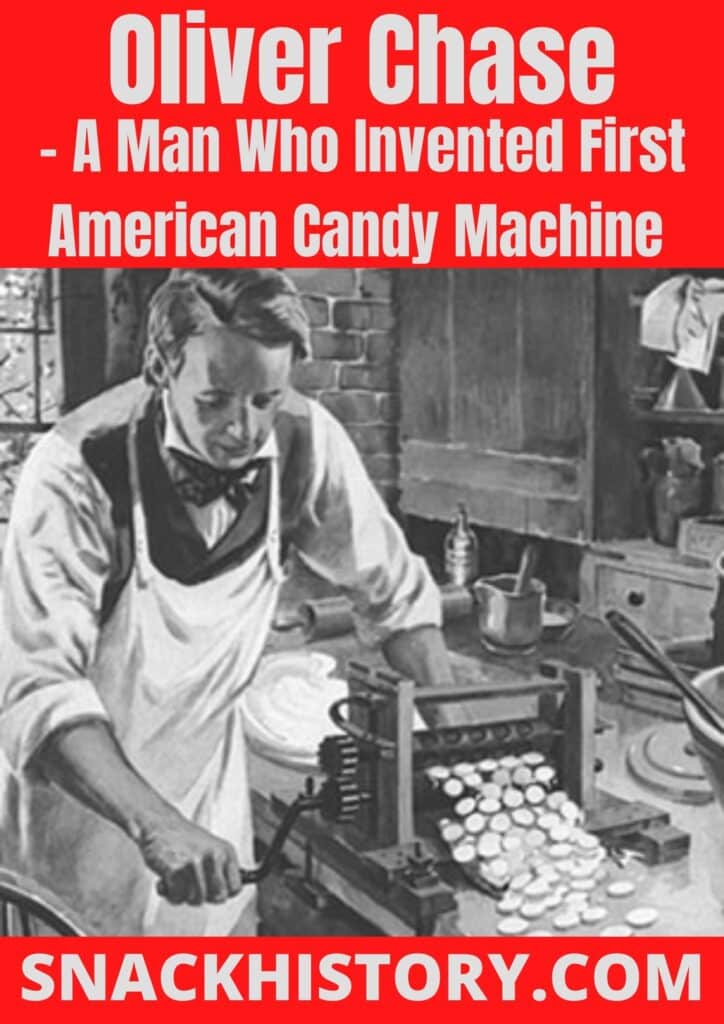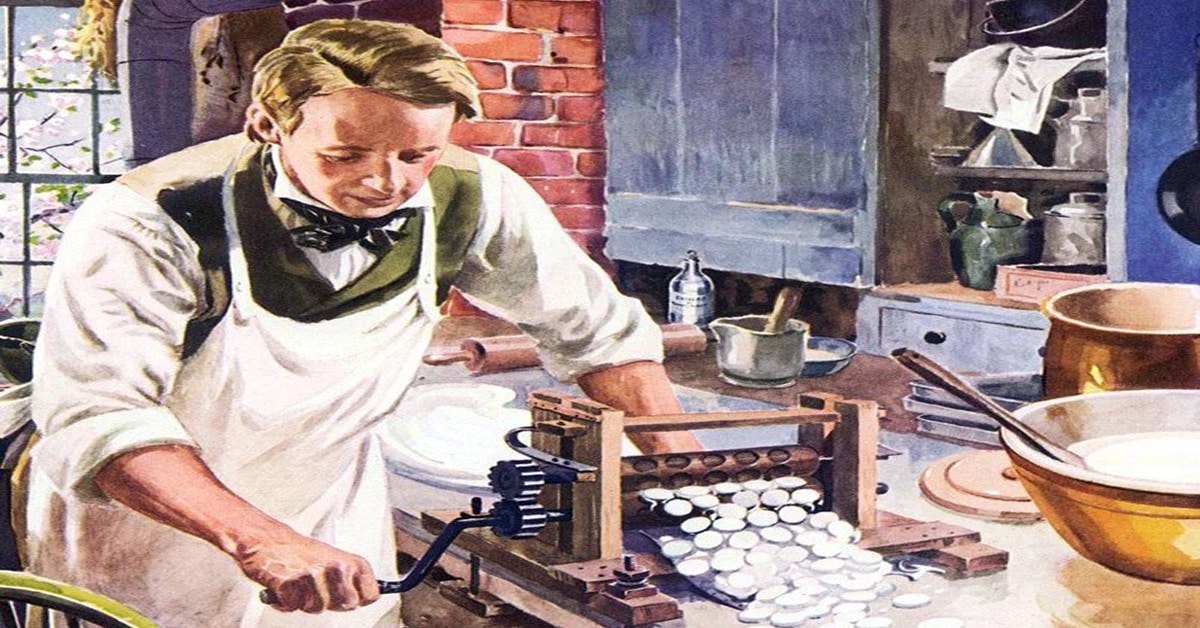Oliver Chase – A Man Who Invented First American Candy Machine
Have you ever wondered who invented the first American candy machine?
Oliver Chase was the man who took this revolutionary step, invented a lozenge cutter, and changed the history of candy-making forever.
Please leave a review or any memories of this snack in the comments at the bottom of this page. Thank you!
In this article, we’ll explore how an American pharmacist managed to change the country’s modern candy industry.

The Confectionery Industry in the 19th Century
It’s not surprising that sugar was expensive back then, but by the 19th century, it had become widely available and the price had dropped due to the increased number of people working on sugar plantations. The sugar was supplied to the major American sweet and confectionery factories back then. However, despite that, the candy was still produced similarly to how it had traditionally been.
Confectioners usually swirled heavy pots that were made from copper on an open flame to prepare hard candies or caramels. Generally, candy was created by rolling components and ingredients repeatedly in hot sugar over several days. Therefore, making candy back then was not only expensive but also required an unimaginable amount of physical work.
The Appearance of Oliver Chase
As you can see, candy and other confectionery manufacturers had a pretty hard time. But that was the time when Oliver Chase came into the candy market and revolutionized the history of candy-making.
Chase was a pharmacy student from England who had just moved to Boston. Oliver was born in England in July 1821 and emigrated to the Boston region in 1847. He created and patented the first candy machine in the United States, a lozenge cutter.
Initially, he worked in the pharmaceutical industry. There he used to make the apothecary lozenges, which were done by forming sugar and gum dough strands into tablets and cutting them into lozenges.
The procedure was nevertheless laborious and slow, despite the use of some crude cutting machines. And there was a large demand for lozenges, particularly once Chase began producing versions that could be consumed as candy instead of medication.
Oliver manufactured gum Arabic, peppermint, and brown sugar-based lozenges by hand while working in both the pharmacy and confectionery industries. When he began to receive a large number of orders from people and, more importantly, stores, he realized the significance of the special cutting machines. Therefore, he started to think about inventing one.
Invention Of Lozenge the Cutting Machine
After many attempts and experiments, Oliver Chase invented the Lozenge – the cutting machine. The groundbreaking invention happened in the year of 1847.
By that time, Oliver Chase was just 26 years old. His creation used a stamp to shape the sugar dough that was placed as sheets into the lozenges in a circular shape. Chase’s new invention was much like the hand-cranked pasta machine.
The machine made it possible to create dozens of lozenges at once, all of a similar size and shape. The innovative device allowed Oliver to produce a lot more lozenges in the depth of the Industrial Revolution. This was one of the main foundations of the establishment of the American candy brands and the start of the mass manufacture of candies.
Oliver Chase Opens His First Business
In South Boston, Oliver Chase, alongside his brother, established a business that made the sweet confectionery, and they called it “Chase lozenges.” Their business subsequently became widely known as Necco’s (New England Confectionery Company).
The company was run by Oliver Chase and soon became the nation’s candy manufacturer with the longest continuous operation. One of the most famous and loved candy products manufactured by them was cinnamon and clove-flavored lozenges.
Oliver Chase’s Inventions Advance
Even though Oliver Chase managed to invent what he needed, the lozenge cutting machine, it was still not enough for him. He continued to innovate after that and repeatedly enhanced and enlarged the lozenge machine. His second big invention was the pulverizing machine, which he invented in 1850 and patented in the same year.
Later, in 1857, he obtained a patent for a new design of his lozenge machine. Although several sources mention a lozenge-cutting machine being patented in 1847, a thorough study of the patents from this era in this technology was unable to validate this claim.
After their successful inventions, Oliver Chase and his brother Daniel soon came up with the idea and concept of writing on their lozenges.
One of the most famous 19th-century confectioneries was the “cockles”. The shell-shaped sugar wafers had paper sayings tucked inside, like fortune cookies. Those treats inspired Oliver Chase to create the candy with writing on it.
The new fortune cookie-type candies were first-hand-printed by the brothers. The length and shape of their lozenge candies gave them the possibility to leave long comments, which once more gave Oliver more options.
Well, writing on candies was a pretty good idea, and it created a bunch of new possibilities for the business. However, Oliver Chase still wanted to make the manufacturing process easier. Therefore, in 1866, he managed to create the device for printing directly on lozenges using a felt roller pad that had been wet with vegetable dye.
All those inventions caused a very significant speedup in manufacturing, and as a result, the business started to grow. In 1902, new types of lozenges were introduced to the market. They had a heart shape and were called “Sweethearts.”
Oliver Chase and his brother undoubtedly made a very huge invention. However, the inventions were made feasible by their surroundings. This was precisely the time when new technologies and automation were required. What was also helpful for the brothers was that the raw materials were available from local providers, and they did not have to put a huge effort into getting those materials.
Other candy makers soon followed Necco’s lead, notably the Daggett Chocolate Company and Squirrel Brand. Soon after the invention, candy manufacturing companies grew rapidly in number. Therefore, the competition in the market has increased a lot.
Bottom Line
The confectionery industry was transformed by Oliver Chase’s ideas. At the 1876 Philadelphia Exposition, approximately two dozen confectionery businesses displayed their industrially produced sweet treats. Candy was becoming an industrial good rather than an artisan one.
Oliver Chase passed away in December 1902 at the age of 81. He died in Massachusetts, USA. Today, Necco Wafers, Canada Mints, and Sweethearts carry on his confectionery legacy.

Nato is a content writer and researcher with a background in psychology. She’s passionate about writing about the candy industry and exploring the cultural significance of sweets and treats. She believes that the stories behind our favorite snacks can reveal a great deal about our values.
Please leave a review or any memories of this snack in the comments below. Thank you!
Click here for a full A-Z list of Snacks and Candy
